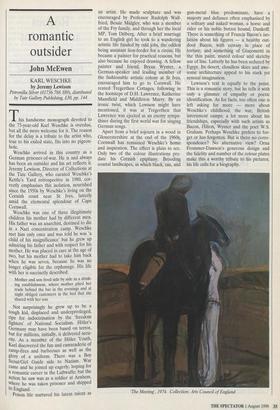A romantic outsider
John McEwen
This handsome monograph devoted to the 73-year-old Karl Weschke is overdue, but all the more welcome for it. The reason for the delay is a tribute to the artist who, true to his exiled state, fits into no pigeon- hole.
Weschke arrived in this country as a German prisoner-of-war. He is and always has been an outsider and his art reflects it. Jeremy Lewison, Director of Collections at the Tate Gallery, who curated Weschke's Kettle's Yard retrospective in 1980, cor- rectly emphasises this isolation, nourished since the 1950s by Weschke's living on the Cornish coast near St Ives, latterly amid the elemental splendour of Cape Cornwall.
Weschke was one of three illegitimate children his mother had by different men. His father was an anarchist, destined to die in a Nazi concentration camp. Weschke met him only once and was told he was 'a child of his insignificance' but he grew up admiring his father and with respect for his mother. He was placed in care at the age of two, but his mother had to take him back when he was seven, because he was no longer eligible for the orphanage. His life With her is succinctly described:
Mother and son lived side by side in a drink- ing establishment, where mother plied her trade behind the bar in the evenings and at night obliged customers in the bed that she shared with her son.
Not surprisingly he grew up to be a tough kid, displaced and underprivileged, ripe for indoctrination by the 'freedom fighters' of National Socialism. Hitler's Germany may have been based on terror, but for millions, initially, it delivered secu- rity. As a member of the Hitler Youth, Karl discovered the fun and camaraderie of camp-fires and barbecues as well as the glory of a uniform. There was a Boy Scout/Girl Guide side to Nazism. War came and he joined up eagerly, hoping for a romantic career in the Luftwaffe; but the action he saw was as a soldier at Arnhem, Where he was taken prisoner and shipped to England. Prison life nurtured his latent talent as an artist. He made sculpture and was encouraged by Professor Rudolph Wall- fried, Bessie Midgley, who was a member of the Fry family, and through her the local MP, Tom Driberg. After a brief marriage to an English girl he took to a wandering artistic life funded by odd jobs, the oddest being assistant lion-feeder for a circus. He became a painter for practical reasons, but also because he enjoyed drawing. A fellow painter and friend, Bryan Wynter, a German-speaker and leading member of the fashionable artistic colony at St Ives, encouraged him to go to Cornwall. He rented Tregerthen Cottages, following in the footsteps of D.H. Lawrence, Katherine Mansfield and Middleton Murry. By an ironic twist, which Lewison might have mentioned, it was at Tregerthen that Lawrence was ejected as an enemy sympa- thiser during the first world war for singing German songs.
Apart from a brief sojourn in a wood in Gloucestershire at the end of the 1960s, Cornwall has remained Weschke's home and inspiration. The effect is plain to see. Only two of the colour illustrations pre- date his Cornish epiphany. Brooding coastal landscapes, in which black, tan, and gun-metal blue predominate, have a majesty and defiance often emphasised by a solitary and naked woman, a horse and rider or his noble borzoi hound, Dankoff. There is something of Francis Bacon's iso- lation about his figures — a healthy out- door Bacon, with ecstasy in place of torture; and something of Giacometti in the thin paint, muted colour and sketchy use of line. Latterly he has been seduced by Egypt. Its desert, cloudless skies and awe- some architecture appeal to his stark yet sensual imagination.
Lewison's text is equally to the point. This is a romantic story, but he tells it with only a glimmer of empathy or poetic identification. As for facts, too often one is left asking for more — more about Weschke's childhood, the war, British internment camps; a lot more about his friendships, especially with such artists as Bacon, Hilton, Wynter and the poet W.S. Graham. Perhaps Weschke prefers to for- get or has forgotten. But is there no corre- spondence? No alternative view? Oma Fronuner-Dawson's generous design and the fidelity and number of the colour plates make this a worthy tribute to his pictures; his life calls for a biography.
'The Meeting', 1974. Collection: Arts Council of England


























































 Previous page
Previous page